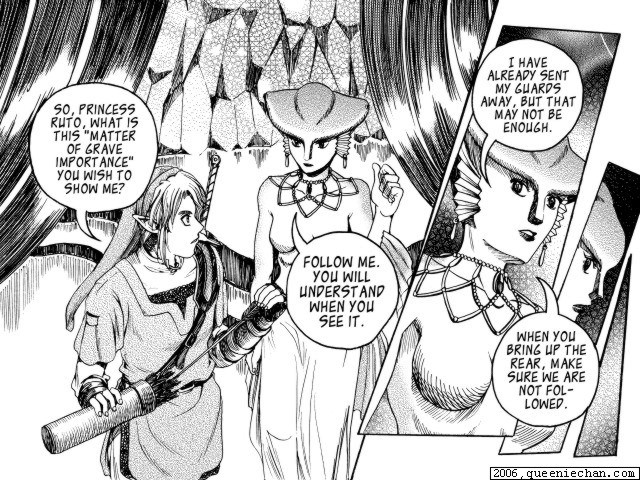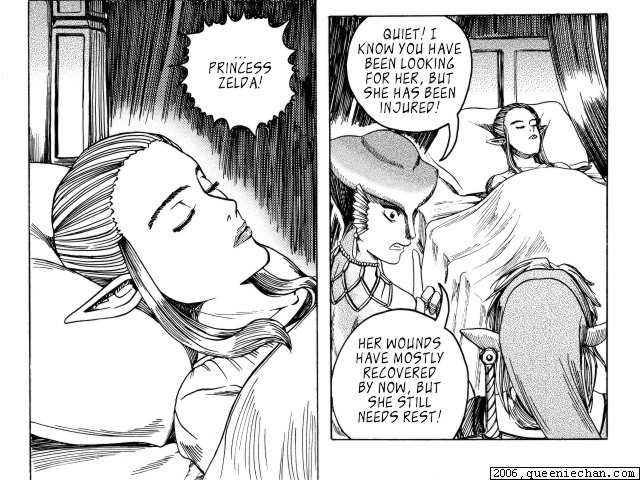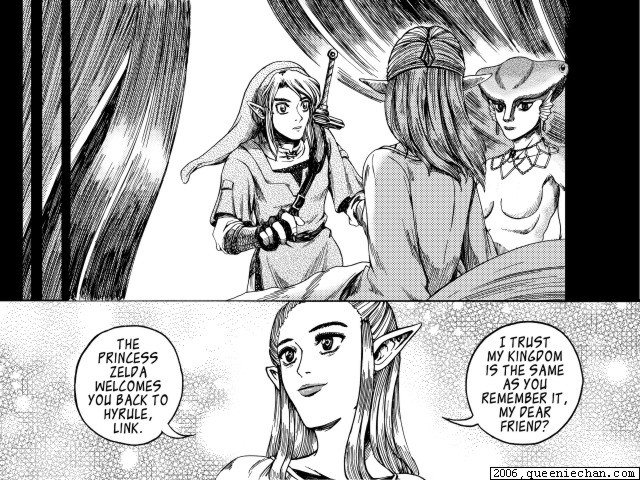The Dreaming v2: I see that volume 2 is up on Amazon.com for pre-orders. It says there that the date it’ll be out is still November 7th, so hopefully that’s the day it WILL actually come out. Volume 1 is still available here, and right now I’m hard pressed to start volume 3. I’m going to do other work until the end of September and then start work on book 3 at the beginning of October. Considering it’s the last volume in the series, it’s taking some work to actually get in the mood to doing it, but that could be because I’m beginning to sketch out the look of the next series I’m doing, which is already fully formed in my head. Details are top secret, ofcourse!
On the Subject of Anthologies
There’s been alot of interesting discussion on manga anthologies these past few weeks, with alot of people in the “for” camp. Ofcourse, anybody who reads manga would welcome the idea of an anthology – in Japan, the anthologies are the lifeblood of the industry, and the manga-style of story-telling is more suited for serialisation anyway. Right now there are already anthologies out there, such as the American version of Shonen Jump and also Shoujo Beat, but then these are just English-translated versions of Japanese magazines. If you were to ask for a anthology to showcase non-Japanese, global manga, how difficult would that be?
Apparently quite difficult, because according to alot of people, anthologies have never been commercially viable outside Japan. The Japanese system has been around so long that it revolves around people buying anthologies printed on crappy paper, and then throwing it away to buy takoubans of their favourite stories. When other countries try the same model with Japanese manga, it sells because there is an inbuilt audience who knows they’re getting a tried-and-true Japanese product (with loads of merchandising). But what about trying it with original, untested work? The financial risk can be pretty great, and printing isn’t cheap either.
Which brings me around to the idea of e-anthologies. This is something that makes alot of people cringe, because they would rather hold a crappily printed book in their hands than shell out money for something “ephemereal” that comes attached to a computer. That’s a reasonable complaint, but one that’s a bit unfair, because personally, I believe that e-books are the way of the future. I just think that it won’t catch on with our current level of technology, though things may change in 5-10 year’s time.
E-Reading
I just outlined the first reason why people want print anthologies rather than digital ones – nothing beats holding the real book in your hands. But then that’s what the collected takouban are for in Japan – you read your story in the anthologies printed on crap, and then you buy the takouban. No one cares what happens to the intermediate medium afterwards; it is ephemeral and disposable. That is why I think e-anthologies may work in the long run, because anthologies in their nature are not meant to be the final product. It’s just a way of letting people have a taste of something without paying alot of money (or having it take up permanent space in their abode).
However, no one likes to fish out their credit card for a $2.00 online transaction. No one likes being forced to sit infront of their computer terminal to read their fluffy entertainment either. Consumers these days want things on-the-go; they want music on-the-go, and now movies on-the-go. They want to go to their favourite cafe and read their book, which brings us to the biggest hurdles e-commerce has yet to tackle: portability, accessibility and affordability. (The iPod has tackled all these problems, but I’ll talk about that later)
The Problem is always Money
Remember when subscription webcomics was meant to help us pay our grocery bills (the ones doing the drawing, that is)? Remember how Paypal was supposed to catch on like a wildfire and make bit-payments easy? Neither happened. Well, Paypal caught on, but not like wildfire, and I have to suffer at least 2 emails a week from scammers pretending to be Paypal. Paypal also keeps demanding I enter my credit card details into my Paypal account (which I’m NOT going to). I thought the whole point of Paypal was so I don’t have to enter my credit card details online. Bottom line: I find Paypal a real pain in the ass at times. It’s great when you’re receiving money, and sucks when you’re paying for something (I have a limit on how much I can pay because of my lack of credit card details).
I know the whole credit card details thing is the reason why alot of people hesistate to shop online. By alot of people, I mean the anecdotal group, namely my extended family. In a group of about 20 people, who shops online at all? One person, me. This is despite everybody else in my extended family having more than 1 credit card. Some use internet banking, but whenever anyone wants to buy anything online, they are either (a)desperate for it, or (b)know that I can buy it for them and they’ll pay me back later. But then these are only the adults, who never tire of the urban legends involving credit card scams. The teenagers don’t have credit cards, and won’t have for a long time, so there goes their chances for online shopping. The end.
A Word About Consumer Psychology
I said before that no one likes to sit at a computer terminal reading fluff entertainment. That will probably be true for the rest of eternity, but there is an additional layer of complexity there. There is some kind of psychological difference between having to log onto a site to read something, and downloading something onto your computer. It’s a peculiar feeling of ownership. I know that if I pay money to buy a movie online, I want to download that movie and save it onto my hard drive. I don’t feel comfortable paying $5 to watch it stream onto my screen. Point is, I can download it onto my hard drive, watch it, and never watch it again or delete it. Either of these experiences would mean I watched a movie once for $5, but the second one is much more rewarding.
It’s rewarding for a simple reason – when someone pays money for a piece of entertainment, they expect to OWN it. It doesn’t matter if it’s $5000 or $0.50, it’s the feeling of entitlement. I used to think that it was the feeling of holding something solid in your hands, but digital music has proved me wrong. People are happy to download digital music by the dozen and pay for it, but they DON’T want to stream it from your website if it means paying. People feel that when you buy something, only YOU have the right to destroy your copy of it. I’ll never pay to watch a streaming movie, because I’ll tell you when I’m tired of this movie and never want to see it again. I’m not letting a movie site decide for me when I shouldn’t be able to watch something I paid $5 for. After all, how many DVDs have I bought that I’ve only watched once?
Technical Hurdles
Which brings me to the subject of portable E-book readers. These have been around for a while. You just don’t see people using them. That’s not to say they don’t read e-books – my friend Paul read the whole Earthsea series on his pocket PC – it’s just that it never really caught on. There were technical difficulties. Battery life problems. Where the heck do I download e-books again? Where would I BUY an e-book reader anyway? How do I pay for it if I buy an e-book online (please don’t say “credit card”)? Is an e-book reader expensive? Will it be cheaper to just buy books? Will the screen glare make my eyes bleed after several hours? Will there be a lag if I turn the page? Can I view photoes and pictures on it (such a waste if I can’t)? Certainly the holy grail of the e-book reader is also the e-comic reader. Why want something that only displays text? Can it come with a touch screen and a 60MB memory backup as well? And so it goes.
Unless I have a one-stop answer to all these problems, I won’t be interested in an e-book reader. Though if an e-book reader catches on with the public, there is bound to be stiff resistence from the established book industry. Old industries are always resistent to change, much like how the iTunes store for Australia was delayed because music industry moguls fought back. How are they going to make money now, if Australians won’t buy their overpriced CDs? Australians have always been ripped off for any kind of entertainment, so ofcourse they embraced the iTunes store (gamers already order everything from overseas anyway). In the end, there was nothing the music industry could do but go with the flow. But it certainly hasn’t been an easy reality for them to accept.
Where the iPod Suceeds
Contrary to popular belief, the iPod succeeded not because of it’s portability, accessibility or affordability (though it is most of these things). The iPod succeeded because it’s cool. It has a sleek, sexy design, and the marketing campaign rode on the late-90s Apple catch-phrase “Be different”. Ofcourse, there are other portable music players out there, but these are considerably less cool. The iPod has the cool factor, and that is enough to make people shell out $400 to get one.
The moral of the story is: it’s not what you’re doing, but how you look while you’re doing it. No one wants a fancy gadget that makes them look like a dork in a public place, no matter how great it is. Does anybody remember Nokia’s disastrous attempt at entering the video gaming market, with the N-Gage? There was a whole website created just to make fun of the idea. Now, if someone wants to design an E-book Reader that takes the world by storm, think about that.
Ofcourse, you presume that people want portable music too, and that’s true as well. My mum wants to get an iPod, because her group of technophobic senior citizens have caught onto the craze too, and she’s figured out how to work the iTunes program on her computer. Because she’s so phobic she won’t even use an ATM machine, it’s a good thing that she can buy $20 iTunes cards from places where she normally shops, like Myers. It’s like magic, or the Octopus Travel card for the Hong Kong public transport system – instead of giving your financial details, you just get an anonymous prepaid card and drop cash on it when you run out. In other words, the e-commerce problem of payment solved in one stroke. If you can get prepaid iTunes cards in Australia, then you can get them anywhere.
Here is a complicated chart demonstrating how the iPod (and iTunes) solved the problem of accessibility, portability and affordability.

In Conclusion
I’ve gone totally off-track from the original topic, which was whether anthologies of global manga can work, but it’s a worthwhile diversion. If an anthology can be done, and it’s an e-anthology, then these are the factors I would consider paramount in creating your e-commerce scheme. Assuming you want global manga anthologies to become a mass-market thing, where every second person is reading it on the train, then the portable e-reading movement has got to be done hand-in-hand with reading real books as well as comic books (and probably newspaper, magazines and anything else involving words). What I’ve done is pointed out a similar model that worked, and explain why I believe it worked.
The reason why I whipped up this highly-sophisticated iPod chart is because the iPod was indeed successful. That speaks volumes in this day and age of crackpot get-rich internet schemes. In fact, the iPod is probably the first mass-scale, commercial product to harness the accessibility and ubiquity of the internet. They reached out to the masses and actually made money off something that can’t be held in your hands – digital music. This goes against what I’ve always assumed about the Psychology of Consumption – that in order to satisfy a paying customer, you have to give them something tangible in exchange. Digital music (and movies, and podcasts) proved this wrong – in fact, in the mere 10 years of the Internet, we’ve gone from “Check out my 56.6 kbps modem” to “I’ve downloaded 100GB of movies, manga and music onto my computer”. These things don’t happen so quickly because they’re a fad, they happen because that’s the direction society is heading it, like it or not. And if digital music is an indication, there isn’t anything the big money makers can do about it.
Animania 2006: I’m going to be attending Animania 2006 at the Sydney Town Hall, though this time I won’t be sitting at the artist’s alley. I can go and have fun for a change! I’m hosting 2 panels, one on Saturday and one on Sunday. Each event runs for an hour at the maximum, and the times for it are:
Saturday (30th Sep) 5:30pm:
Love Revisited: Exploring how yaoi and yuri relationships are expressed in Japanese popular entertainment
Sunday (1st Oct) 11:30am:
“Anime, Manga & Internet” discussion forum
Sunday (1st Oct) 12:30pm:
An interview with Queenie Chan






 ————————————
————————————



